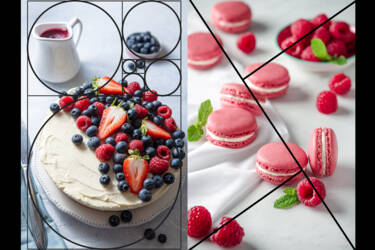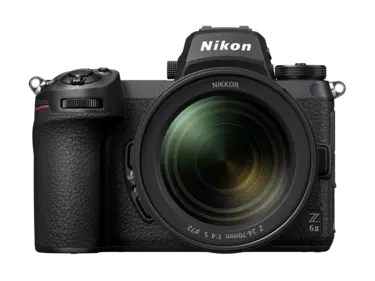7 composition grids to try for better food photography

Take the guesswork out of framing and create effortless professional photos with these seven composition grids
Effective composition is what separates a good image from an excellent one. It’s the art of arranging elements in a frame to guide the viewer’s eye and capture their attention, making your photos visually striking.
After working for more than a decade as a professional food photographer with top clients such as National Geographic Food, Tesco and Waitrose, I’ve learned how powerful composition can be.
How to use these grids:
The best way is to use these grids in the capture phase to guide your composition, but you can also use them as a crop tool in post-production. You can rotate and flip them in any direction and they will still be effective. With practice, they will become second nature and you’ll start seeing the lines in your head!


The rule of thirds: start with the fundamentals
You might be familiar with the classic grid view that divides the frame into nine equal rectangles. This grid is so popular because it is the simplest way to make your images visually more interesting.
How to use it: Place your subject off-centre, along the grid lines or where they intersect to create a dynamic and engaging composition. This is very effective in minimalistic pictures with one main subject and works well paired with negative space. Not overwhelming the frame with many elements gives the viewer’s eyes a moment to ‘breathe’, allowing them to fully appreciate the subject without distractions.


The phi grid: a smarter rule of thirds
The phi grid works better when you want to add props to the story while keeping the main dish as the hero and avoiding the stiffness of perfectly centred compositions.
How to use it: Place your subject closer to the centre and the props in the four corner rectangles, which creates a natural frame around your subject and makes the composition feel less crowded. Make sure the supporting elements are visually lighter or smaller than the subject to create a sense of hierarchy, especially when photographing overhead.


The golden spiral: for effortless flow
The golden spiral is a visualisation of the golden ratio, a mathematical formula that rules visual harmony and proportions. It’s a remarkable principle observed in nature (think of seashells and galaxies) that has been used by artists for centuries. It can be visualised as a spiral that smoothly guides the viewer’s eyes through the frame. It’s perfect when you want to create flow and movement.
How to use it: Place your subject in the centre of the spiral with the supporting elements around it, along the curved line. It’s great for overhead angles and busier settings. Use an AF-S NIKKOR 50mm f/1.8 G lens (Z mount users can try the NIKKOR Z 50mm f/1.8 S or use an FTZII adapter with an F mount lens) at medium apertures such as f/7.1 to capture a wider frame and ensure sharpness in the whole scene.


The golden circles: for balanced proportions
The golden ratio can also be illustrated as a series of circles that tell you exactly how to balance the proportion of your subject and props. You can match their size or visual importance to the size of the circles for harmony.
How to use them: Use circles for proportions, visual weight and position. The largest circle represents your main subject, while the smaller circles are the ideal size and placement for props such as side dishes or garnishes.


The golden triangles: for dynamic images
This grid divides your frame into four triangles, guiding the viewer’s eye along diagonal lines. It’s great for creating movement and making your images look dynamic and energetic.
How to use them: Try this with smaller foods such as chocolates, cupcakes or macarons. Arrange your subject along the main diagonal, at the intersection of the triangles, and place your props, food, or garnish along the shorter triangle lines. Use a longer focal length like an AF-S NIKKOR 85mm f/1.8 G (or NIKKOR Z 85mm f/1.8 S for Z mount) at a large aperture like f/4 to isolate your subject and add even more depth to your scene.


Use symmetry to convey importance
Sometimes placing your subject smack in the centre of the frame can give it importance and create a bold and impactful look, especially if working with visually rich, styled subjects.
How to use it: Try it in flat lays with dishes that have circular shapes, such as pizzas, bowls or plates, in minimalistic compositions. Symmetry doesn’t have to be rigid. Experiment with breaking it slightly by adding a pop of colour or texture on one side of the dish, such as some garnish, a napkin or cutlery, which makes it more interesting without losing the overall balance.


Dynamic symmetry: guide with leading lines
This grid is built on many intersecting lines, and it can help you break out of more rigid, straight-line compositions. It can look quite confusing, but see it as an endless combination of strong leading lines that guide the viewer’s eye naturally from the corners straight to the subject.
How to use it: Start by positioning your main subject in the centre, within the hexagon formed by the lines. Then arrange the props along the lines generated from the corners. Cutlery makes a great leading line – think of a knife cutting through a cake or a fork resting on the side of the plate.


Mix and match: master composition like a pro
Using one grid is powerful, but combining them will immediately give your images an edge. Many of them, like the phi grid, golden spiral, golden circles, golden triangles and dynamic symmetry, result from the same mathematical principles, so they naturally complement each other.
How to use them: Decide on your primary grid to position your subject, then layer the others. For example, in an overhead angle of a busy table, you could use the golden spiral and rule of thirds to place the main dish, then the golden circles to get the right proportions between the subject and props, and finally create leading lines with cutlery and garnish along the dynamic symmetry grid.


Hungry for more?
Featured products
Get started here

Unlock greater creativity











